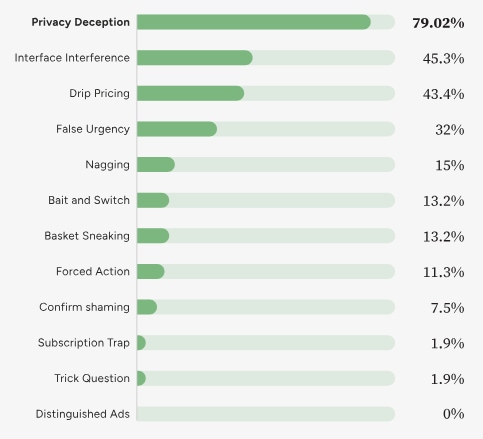 Dark patterns are tactics used by online platforms to mislead customers and prevent them from making right choices. (Representative image)
Dark patterns are tactics used by online platforms to mislead customers and prevent them from making right choices. (Representative image)
What is the government’s stand against the ‘ dark patterns’ in e-commerce? Take a look at the essential concepts, terms, quotes, or phenomena every day and brush up your knowledge. Here’s your knowledge nugget for today.
Knowledge Nugget: Dark patterns in e-commerce
Subject: Government policies and interventions
(Relevance: The government has taken several steps for consumer protection, from enacting the Consumer Protection Act to launching the app for easing the filing of cases. In this regard, it becomes essential to understand the growing concern around ‘dark patterns’ in e-commerce for your UPSC exam preparation.)
Why in the news?
To identify and eliminate dark patterns on e-commerce platforms, the government has asked e-commerce platforms to regularly conduct an audit on their platforms. “Companies must not wait for the Central Consumer Protection Authority (CCPA) to intervene. They should proactively recognize and remove these deceptive practices before notices are issued. This is not regulatory compliance: it’s about building trust with your consumers,” said Consumer Affairs Minister Pralhad Joshi.
Key Takeaways:
1. Dark patterns, also known as deceptive patterns, is the term used to describe the ways in which websites or apps make their users do things that the users do not intend to do or would not otherwise do, as well as to discourage user behaviour that is not beneficial for the companies.
2. Understand ‘dark pattern’ through example: Think of that annoying advertisement that keeps popping up on your screen, and you can’t find the cross mark ‘X’ to make it go away because the mark is too small to notice (or to click/ tap). Worse, when you try to click/ tap on the tiny ‘X’, you sometimes end up tapping the ad instead.
3. The term dark patterns was coined by Harry Brignull, a London-based user experience (UX) designer, in 2010. The Internet is replete with examples of dark patterns. On December 1, 2023, the CCPA issued guidelines for the “prevention and regulation” of dark patterns. It has specified 13 dark patterns.
(i) False urgency: Creates a sense of urgency or scarcity to pressure consumers into making a purchase or taking an action. It includes showing false popularity of a product or service to manipulate user decisions or stating that quantities of a particular product or service are more limited than they actually are.
(ii) Basket sneaking: Dark patterns are used to add additional products or services to the shopping cart without the user’s consent.
(iii) Confirm shaming: Uses guilt to make consumers adhere; criticises or attacks consumers for not conforming to a particular belief or viewpoint.
(iv) Forced action: Pushes consumers into taking an action they may not want to take, such as signing up for a service in order to access content.
(v) Nagging: User is disrupted and annoyed by repeated and persistent interactions, in the form of requests, information, options, or interruptions, to effectuate a transaction and make some commercial gains, unless specifically permitted by the user.
(vi) Subscription traps: Easy to sign up for a service but difficult to quit or cancel; option is hidden or requires multiple steps; forcing a user to provide payment details or authorization for auto debits for availing a free subscription; or making the instructions related to cancellation of subscription ambiguous, latent, confusing, cumbersome.
(vii) Bait & switch: Advertising a certain product/ service but delivering another, often of lower quality;
(viii) Rogue Malwares: Using a ransomware or scareware to mislead or trick user into believing there is a virus on their computer and aims to convince them to pay for a fake malware removal tool that actually installs malware on their computer.
(ix) Disguised ads: Designed to look like content, such as news articles or user-generated content.
(x) Interface interference: Manipulate the user interface in a way that highlights certain specific information and obscures other obscures other relevant information relative to the other information; to misdirect a user from taking an action as desired.
(xi) Drip pricing: A ‘dark pattern’ practice whereby elements of prices are not revealed upfront or are revealed surreptitiously within the user experience, or revealing the price post-confirmation of purchase, or a product or service is advertised as free without appropriate disclosure of the fact that the continuation of use requires in-app purchase.
(xii) Trick Question: Deliberate use of confusing or vague language like confusing wording, double negatives, or other similar tricks, in order to misguide or misdirect a user from taking the desired action or leading the consumer to take a specific response or action.
(xiii) Saas billing: Generating and collecting payments from consumers on a recurring basis in a software as a service (SaaS) business model by exploiting positive acquisition loops in recurring subscriptions to get money from users as surreptitiously as possible.
| E-Jagriti |
| The Department of Consumer Affairs, in collaboration with the National Informatics Centre (NIC), developed E-Jagriti, an integrated digital system combining e-Daakhil, Confonet, and OCMS into a single, streamlined platform. It aims to simplify access for consumers, commission officials, judges, advocates, industry experts, and mediators. ‘Jago Grahak Jago App,’ ‘Jagriti App,’ and ‘Jagriti Dashboard’ were launched on the occasion of the National Consumer Day 2024, which is celebrated on 24th of December every year. |
Advertising Standards Council of India (ASCI) and UI/UX design company Parallel HQ Study
📍According to the study published by ASCI and UI/UX in August 2024, over 79 per cent of Indian apps trick users into giving away their personal data. It identified dark patterns in more than 50 Indian apps across sectors such as e-commerce, health, and fintech as well as cab-booking services and delivery platforms, with a total of 21 billion downloads.
📍It found that a majority of dark patterns were used by travel booking apps like Goibibo, MakeMyTrip and EaseMyTrip followed by delivery and logistics apps such as Zomato, Swiggy, Zepto, Borzo, etc.
 Percentage of apps containing each dark pattern. (Image credit: ASCI)
Percentage of apps containing each dark pattern. (Image credit: ASCI)
📍E-commerce apps like Amazon, Flipkart, and Nykaa, among others, make it difficult for their users to delete their account, the study found. Additionally, four out of five health tech apps rushed users into making decisions through a tactic known as False Urgency.
BEYOND THE NUGGET: Central Consumer Protection Authority (CCPA)
1. CCPA is is being constituted under Section 10(1) of The Consumer Protection Act, 2019. The Act replaced the Consumer Protection Act, 1986, and seeks to widen its scope in addressing consumer concerns. It has come into force w.e.f 24th July 2020. It aims to protect the rights of the consumer by cracking down on unfair trade practices, and false and misleading advertisements that are detrimental to the interests of the public and consumers.
2. CCPA has the power to inquire or investigate into matters relating to violations of consumer rights or unfair trade practices suo motu, or on a complaint received, or on a direction from the central government.
3. The Act provides that the CCPA consists of a Chief Commissioner and such number of other Commissioners as may be prescribed, to be appointed by the Central Government to exercise the powers and discharge the functions under this Act.
4. The power to make rules to provide for the qualifications for appointment, term of office, salaries and allowances, resignation, removal, and other terms and conditions of the service of the Chief Commissioner and Commissioners of the Central Authority is bestowed upon the Central government.
5. The CCPA also has an Investigation Wing that is headed by a Director General. District Collectors, too, have the power to investigate complaints of violations of consumer rights, unfair trade practices, and false or misleading advertisements.
Post read question
Consider the following statements:
1. Dark pattern is a deceptive attempt made by e-commerce platforms to make users do things that they otherwise wouldn’t.
2. ‘Saas billing’ is identified as a dark pattern by the Central Consumer Protection Authority (CCPA).
3. In the ‘Bait and Switch’ dark pattern, elements of prices are not revealed upfront or are revealed post-confirmation of purchase.
How many of the above statements are correct?
(a) Only one
(b) Only two
(c) All three
(d) None
| Answer key |
| (b) |
Subscribe to our UPSC newsletter. Stay updated with the latest UPSC articles by joining our Telegram channel – IndianExpress UPSC Hub, and follow us on Instagram and X.
🚨 Click Here to read the UPSC Essentials magazine for May 2025. Share your views and suggestions in the comment box or at manas.srivastava@indianexpress.com🚨


